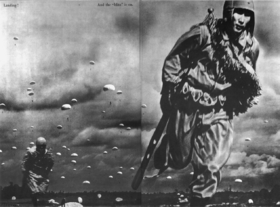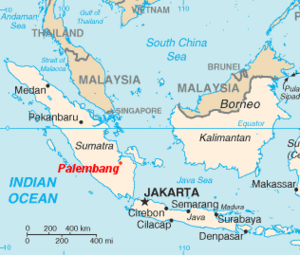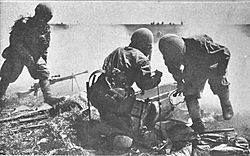Battle of Palembang facts for kids
Quick facts for kids Battle of Palembang |
|||||||
|---|---|---|---|---|---|---|---|
| Part of World War II, Pacific War | |||||||
 Japanese paratroopers landing at Palembang |
|||||||
|
|||||||
| Belligerents | |||||||
| Commanders and leaders | |||||||
| Units involved | |||||||
|
|
||||||
| Strength | |||||||
| 2,000 infantry 50 aircraft |
3,000 amphibious force 350 paratroopers 3 squadrons transports 1 bomber group 2 fighter groups |
||||||
The Battle of Palembang was an important fight during World War II in the Pacific War area. It happened near Palembang, on the island of Sumatra, from February 13 to 15, 1942. The main goal for Japan was to capture the oil refineries owned by Royal Dutch Shell in a nearby place called Plaju.
Japan needed oil because the United States, the Netherlands, and the United Kingdom had stopped selling it to them. This happened after Japan invaded China and committed massive atrocities there. Palembang was also important because it had lots of fuel and airfields. This made it a key military base for both the Allies and the Japanese.
Preparing for Battle

In January 1942, the Allied forces, known as the American-British-Dutch-Australian Command (ABDACOM), decided to gather their air power in Sumatra. They used two airfields near Palembang: Pangkalan Benteng (also called "P1") and a secret base at Prabumulih (known as "P2").
The British Royal Air Force (RAF) formed a bomber group at Palembang. This group included planes from Australia and many Australian pilots. They had about 40 Bristol Blenheim light bombers and 35 Lockheed Hudson light bombers. Some of these planes were older and had been used in other parts of the war. A few American B-17 Flying Fortress bombers were also there briefly but left before the battle.
Another RAF fighter group arrived in early February. They had Hawker Hurricane fighter planes brought by the aircraft carrier HMS Indomitable. Other British, Australian, and New Zealand Hurricane and Brewster Buffalo squadrons joined them. These planes had seen heavy fighting in earlier battles.
The local army, called the Royal Netherlands East Indies Army (KNIL), had about 2,000 soldiers in the Palembang area. These troops were led by Lieutenant Colonel L. N. W. Vogelesang. They included a garrison battalion and local defense groups. The Royal Netherlands Navy also had a few ships on the Musi River.
The Battle Begins
Air Attack on Palembang
On February 13, Allied planes attacked Japanese ships. At the same time, Japanese transport planes dropped paratroopers from the Imperial Japanese Army Air Force (IJAAF) over Pangkalan Benteng airfield. Other Japanese bombers dropped supplies for these paratroopers. Many fighter planes protected the Japanese aircraft.
About 180 Japanese paratroopers landed between Palembang and Pangkalan Benteng. Another 90 landed west of the oil refineries at Pladjoe. The paratroopers did not capture the airfield. However, they took control of the entire Pladjoe oil refinery complex without damaging it.
Local defense troops and anti-aircraft gunners tried to take back the refinery. They succeeded but lost many soldiers because the Japanese were hiding in the refinery's air raid shelters. The plan to destroy the refinery did not cause much damage, but the oil storage tanks caught fire. A few hours later, 60 more Japanese paratroopers landed near the airfield.
By February 14, the remaining Japanese paratroopers moved towards the Musi, Salang, and Telang rivers near Palembang.
Sea Invasion
The main Japanese invasion force was a large fleet of ships led by Vice-Admiral Jisaburo Ozawa. This fleet was sailing from French Indochina. It carried thousands of Japanese soldiers. The fleet included many transport ships, escorted by cruisers and destroyers. There was also an aircraft carrier, the Ryujo, providing air cover.
On the morning of February 13, a small British ship, HMS Li Wo, ran into the Japanese fleet. This ship was carrying people and equipment. Even though Li Wo only had a small gun and two machine guns, its crew bravely fired at the Japanese troop ships. They set one ship on fire and damaged others. This fight lasted 90 minutes until Li Wo ran out of ammunition.
The ship's commander, Lieutenant Thomas Wilkinson, then ordered his ship to crash into the nearest Japanese transport ship. Soon after, his ship was destroyed by Japanese fire. Lieutenant Wilkinson was given the Victoria Cross (VC) after his death. This is the highest award for bravery in the British Commonwealth. It was the only VC given during the Dutch East Indies campaign.
On February 15, an Allied naval force tried to stop the Japanese fleet. This force included five cruisers and ten destroyers, led by Admiral Karel Doorman. However, planes from the Japanese aircraft carrier Ryujo and other land-based planes attacked the Allied ships. This forced the Allied ships to retreat south of Sumatra.
As the Japanese landing force got closer to Sumatra, the remaining Allied aircraft attacked them. They managed to sink one Japanese transport ship. Hurricane fighter planes flew along the rivers, shooting at Japanese landing boats.
However, on the afternoon of February 15, all Allied aircraft were ordered to Java. A major Japanese attack was expected there. By the evening of February 16, 1942, all Allied air units had left southern Sumatra. Other Allied personnel were evacuated by ships from Oosthaven (now Bandar Lampung) to Java or India.



